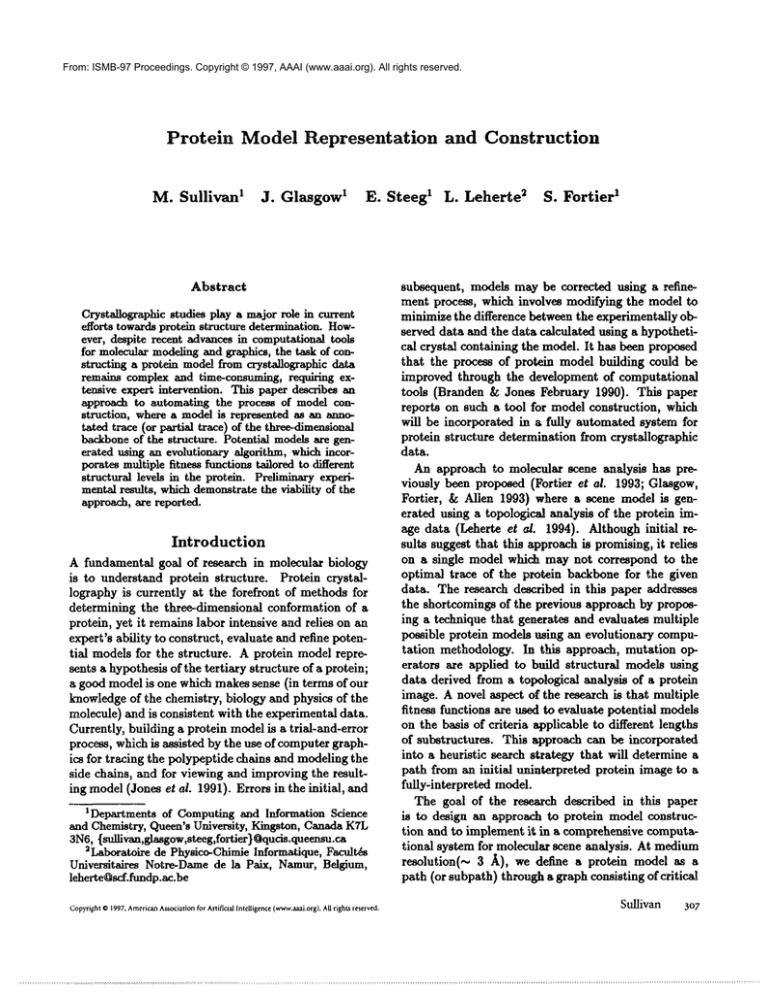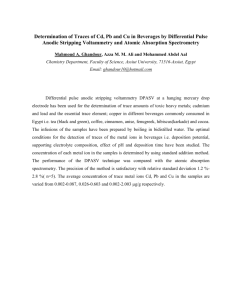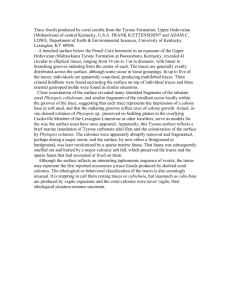
From: ISMB-97 Proceedings. Copyright © 1997, AAAI (www.aaai.org). All rights reserved.
Protein
M. Sullivan
Model Representation
1 J.
and Construction
Glasgow I E. Steeg I L. Leherte
Abstract
Crystallographic studies play a major role in current
efforts towards protein structure determination. However, despite recent advances in computational tools
for molecular modelinE and graphics, the task of constructing a protein modelfrom crystallographic data
remalna complex and time-con~a~mlng,requiring extensive expert intervention. This l~per describes an
approach to automating the proce~ of model construction, where a model is represented as an annotated trace (or partial trace) of the three-dimensional
backboneof the structure. Potential modelsare generated using an evolutionary algorithm, which incorporates multiple fitness functions tailored to different
structural levels in the protein. Preliminary experimental results, whichdemonstratethe viability of the
approach, are reported.
Introduction
A fundamental goal of research in molecular biology
is to understand protein structure. Protein crystallography is currently at the forefront of methods for
determining the three-dlmensional conformation of a
protein, yet it remains labor intensive and relies on an
expert’s ability to construct, evaluate and refine potential models for the structure. A protein model represents a hypothesis of the tertiary structure of a protein;
a good model is one which makes sense (in terms of our
knowledgeof the chemistry, biology and physics of the
molecule) and is consistent with the experimental data.
Currently, building a protein modelis a trial-and-error
process, which is assisted by the use of computergraphics for tracing the polypeptide chains and modeling the
side chains, and for viewing and improving the resulting model(Jones et al. 1991). Errors in the initial, and
I Departments of Computingand Information Science
and Chemistry, Queen’s University, Kin~ton, Canada K7L
3N6,{sullivan,glasgow,steeg,fortier} ~qucis.queensu.ca
aLaboratoire de Physico-Chimielnformatique, Facult~s
Univexsitaires Notre-Damede la Paix, Namur, Belgium,
leherte~scf.fundp.ac.be
CopyrightO 1997, AmericanAssociation for Artificial Intelligence (www.aaai.orgl.All rights reserved.
2 IS.
Fortier
subsequent, models may be corrected using a refinement process, which involves modifying the model to
minimize the difference between the experimentally observed data and the data calculated using a hypothetical crystal containing the model. It has been proposed
that the process of protein model building could be
improved through the development of computational
tools (Branden & Jones February 1990). This paper
reports on such a tool for model construction, which
will be incorporated in a fully automated system for
protein structure determination from crystallographic
data.
An approach to molecular scene analysis has previously been proposed(Fortier et al. 1993; Glasgow,
Foztier, & Alien 1993) where a scene model is generated using a topological analysis of the protein image data (Leherte et el. 1994). Although initial results suggest that this approach is promising, it rehes
on a single model which may not correspond to the
optimal trace of the protein backbone for the given
data. The research described in this paper addresses
the shortcomings of the previous approach by proposing a technique that generates and evaluates multiple
possible protein models using an evolutionary computation methodology. In this approach, mutation operators are applied to build structural models using
data derived from a topological analysis of a protein
image. A novel aspect of the research is that multiple
fitness functions are used to evaluate potential models
on the basis of criteria applicable to different lengths
of substructures. This approach can be incorporated
into a heuristic search strategy that will determine a
path from an initial uninterpreted protein image to a
fully-interpreted model.
The goal of the research described in this paper
is to design an approach to protein model construction and to implement it in a comprehensive computational system for molecular scene analysis. At medium
resolution(,,,
3 ,~), we define a protein model as
path (or subpath) through a graph consisting of critical
Sullivan
307
point nodes, corresponding to amino acid residues, and
weighted edges, corresponding to potential polypep.
tide bonds. A model also specifies a set of environments, which describe properties of the individual critical point nodes on the graph corresponding to amino
acid residue classes.
Model
Construction
In this section we describe an intelligent system for
generating protein models from a critical point graph.
A model corresponds to a trace of the graph corresponding to a potential backbone for the protein. It
is not our goal to find the "best" model for the structure, only to determine a set of reasonable - in terms of
our knowledge of the molecule and physical/chemical
constraints - models which can then be put through a
more rigorous evaluation process to find the best candidates to participate in the next iteration of image
refinement and generation.
An evolutionary programming(Fogel 1995) approach
was developed to generate potential backbone traces
for a protein. This approach involves taking a population (a set of potential traces) and probabilistically
selecting the "fittest" traces with respect to a given
evaluation function. The chosen traces are then modified and placed in the next generation for a population. Successive generations of populations lead to new
and expanded protein traces being created and examined. A gro~rth model is utilized to track the backbone trace through the graph. The basic tenet of this
growth methodology is to apply transformational (intelligent mutation) operators to incrementally extend
and develop members of a population of traces. We
incorporate three such operations in our system: 1)
an add mutation extends a trace by adding an edge to
the path; 2) a delete mutation removes an edge from
the end of a path; and 3) a split mutation probablistically removes an internal edge resulting in two new
subtraces. Figure 1 illustrates the application of these
three operations to a trace in a given population.
Our evolutionary system is novel in the sense that
it evaluates potential modelsat varying structural levels of the protein. Wedivide our traces into multiple
classes and use specialized fitness criteria for each class
as specified in Table 1. Note that individual criteria
not only address different lengths of traces, but also
different structural levels: Class 1 focuses on local distance and angle criteria amongresidues; Class 2 looks
at secondary structure conformations; and Class 3 examines super-secondary structure interactions.
Different fitness functions are incorporated into the
system using a variation of the island model (Davis
1991). Instead of maintaining a single population of
308
ISMB-97
Figure 1: Mutation operations for evolutionary approach
to trace generation.
~
PD
Population
n
h
Figure 2: Abstract view of the evolutionary programusing
a three-islands model.
traces, the system considers multiple populations, one
for each class of traces. Individual populations are isolated and do not communicate with other populations
except through the process of emigration: when a population generates a trace that is outside its bounds,
then the trace is movedto the appropriate population.
For example, if the population illustrated in Figure
1 was restricted to traces of length 7 to 20, then the
traces resulting from the split mutation could emigrate
to a population of smaller paths. Thus, the populations can be viewed abstractly as a group of islands
(see Figure 2) where paths may emigrate from one island to another as a result of intelligent mutation.
The basic algorithm for the evolutionary program
consists of the following steps:
¯ Build the initial population of traces by randomly
selecting single edges from the critical point graph.
¯ Repeat until the new population is full:
-Retrieve
a trace
from the population
using a
Table 1: Fitness function criteria for different island classes.
[[
CLASS [ TRACE LENGTHI FITNESS FUNGI’ION CRITERIA
I!
1
1- 6
Graph edge weights and simple bond angles
2
7-20
Bondand torsion angles, residue dis/~ces
Super-secondary structure
3
21 - 30
tournamentI selection technique.
- Perform mutation in a probabilistic fashion.
- Add the trace to the new population.
Table 2: Results of testing fitness function for island
1.
II Length
H 41
Correct
1 Duplicate
1 Jump
1
2. Duplicates
Iteratively process the multiple populations (using
intelligent mutation operations) until a desired result
or stopping criteria is achieved.
Test Results
The evolutionary algorithm for generating traces was
implemented and tested using two islands. Following,
we describe the fitness functions for each of these islands and experimental results of applying the algorithm to critical point graphs constructed from crystallographic data.
Island 1:
Traces of length 1 to 6 are ranked
using a fitness function based on edge weights (from
the critical point graph) and bond angles. In order to
determine the preferred ranges for values, experimental
data were acquired and a discrete binned distribution
(histogram) was calculated for both the weights and
51 6 [ 7 II
5 10 6
4 4
2
2 3
2
(a) results for 2rn2
II
ngt
II 3,1 4[ 5 [ 6 I fv-II
Correct
1 Duplicate
1 Jump
2 Duplicates
1 Dup/1 Jump
i 2 Dup/1 jump
2
4
1
.
14
5
3
1
1
2
10
9
2
4
5
1
7
8
1
6
3
(b) results for f389
angles.
A reward/punishment technique was used to calculate the fitness value for a trace. Rewards (positive
values) or punishments (negative values) are awarded
based on the region the weights and angles fell into for
a given trace. The fitness value for a trace T is simply
a sum of the reward/punishment function (RPF1) applied to the weight of each edge (We) and each angle
(0) in the trace:
fitness(T)
= ~ RPFI(W,)
eET
+ ~ RPFI(O)
$ET
The fitness function for island 1 was tested on proteins Phospholipase A2 (f389) and Ribonuclease
(2rn2). Testing was performed for an island size
~
100 and a single run consisted of 20 generations.
The algorithm was run 40 times for protein 2rn2 and
100 times for protein f389 and the fittest memberof
t A tournament selection involves repeatedly randomly
choosing some numbern of individuals from the popula.
tion and retaining the fittest individual for the intermediate
population.
~Initially tests were carried out with longer runs. However, little improvement
was found after 20 generations.
the population selected at the end of each run. Table 2
illustrates the results of these runs. For 2rn2, 21 out of
the 40 runs produced correct traces that spanned a portion of the protein backbone. The remaining 19 runs
produced traces that either omitted a single residue
from the backbone or contained a repeat of a residue.
That is, traces of the form < 12_13_14_15_17_18 >
(residue 16 was skipped) or < 12_13_13_14_15_16
(residue 13 was represented as two distinct critical
points) were generated. The results for protein f389
were not quite as positive: 36 out of 100 of the traces
were totally correct. Runs for this protein also produced several traces (8 in total) that contained disulfide bridge connections. Errors also occurred when a
trace reaches the end of the backbone, but continues
to add edges.
On thewhole,theresults
forisland1 werepromising.Alltraces
withinfeasible
inter-residue
distances
or angleswereeliminated
fromconsideration.
Theincorrect
tracesthatremained
in the population
were
onesthatcouldnotbe discarded
basedon localcriteriaalone(e.g.,
connectivity
through
critical
points
corresponding
to sidechains).
The important
result
Sullivan
309
is that for both proteins we produced multiple good
traces of length 7 that could be exported to the second
island.
Island 2: The fitness function for traces of length
7 to 20 is based on a Bayesian model of the distributions of simple angles, torsion angles and inter-residue
distances in knownsecondary structure classes across
a set of diverse protein backbone structures.
First, a finite mixture model of Ganssians (for distance data) and Von Mises circular distributions (for
angle data) was learned using a modified version of
the SNOBminimal message length (MML)classifier
(Wallace
& Dowe1994).The training
dataconsisted
of over10,000examples
of tracesof lengths4 and7
calculated
directly
fromProteinDataBankstructure
files,fromgenerated
electron
density
mapswithnoise
added,and fromexperimental
mapspreprocessed
usingOrcrit.
Currently,
thetrained
secondary
structure
recognition
moduleis usedonlyto estimate
thelikelihood
thata traceis indeed
characteristic
of a valid
proteinbackbone.
Ongoingresearch
involves
consideringa setof modules
trained
forrecognition
of helix,
sheet,
turn,andcoilclasses,
so thathigher-order
information
patterns
(e.g.,
"runs"
of helixor sheet)
can
be rewarded or penalized as appropriate. As in island
1, the current fitness function for island 2 is a sum, in
this case over the segments s of length 4 of a trace:
fitness(T)
= E RPF2(s),
sET
where RPF2(s) is a nonlinear reward/penalty function
that imposes a heavy penalty on segments showing low
likelihood of fitting a real protein backbonestructure
and produces graduated rewards for segments showing
higher likelihood values.
The fitness function for island 2 was tested on proteins f389 and 2rn2. The results generated were
mixed. 30 runs were performed, each resulting in a
trace of length 8 - 20. The shorter traces (length
8-10) were found to be totally correct. Although
longer traces contained correct subtraces, they often
had jumps (incorrect bonds) between correct models
of the backbone. One reason for this is that although
the angles for the incorrect portions made chemical
sense, the distances deviated from the norm. This suggests that a greater emphasis should be placed on distance criteria. Also note, that although island 2 introduced occasional errors, it often managedto improve
on traces that were passed on by island 1.
The evolutionary approach to model construction allows us to derive potential traces of a protein backbone
using both local and global evaluation criteria. Our
models also contain other valuable information, in the
31o
1SMB-97
form of environments, which can be used to associate
critical points with individual residues in the sequence
(Baxter et al. 1996).
Currently, our fitness functions for modelgeneration
only consider a modelin terms of its trace. Future research will involve investigating the use of environment
information in the fitness criteria. As well, we plan to
incorporate additional islands, and corresponding fitness functions, to take into consideration further global
constraints (such as super-secondary structure preferences) in the evolutionary system. Our ultimate goal is
to integrate the model construction module with other
processes (image generation, model evaluation and image refnement) that are being developed for molecular
sceneanalysis.
References
Baxter,
K.;Steeg,E.;Lathrop,
R.;Glasgow,
J.;and
Fortier,
S. 1996.Fromelectron
density
andsequence
to
structure:
Integrating
protein
image
analysis
andthreading for structure determination. In Proceedings o] the
4th International Conferenceon Intelligent Systems ]or
Molecular Biology. AAAI/MITPress.
Branden, C., and Jones, T. February 1990. Betweenobjectivity and subjectivity. Nature343:687--689.
Davis, L., ed. 1991. Handbooko] Genetic Algorithms. Van
Nostrand Reinhold, NewYork.
Fogel, D. 1995. Evolutionary computation: Toward a
nero philosophy o] machineintelligence. IEEEPress, New
York.
Fortier, S.; Castleden,I.; Glasgow,J.; Conklln~ D.; Walmshy, C.; Leherte, L.; and Allen, F. 1993. Molecularscene
analysis: The integration of direct methodsand artificial intelligence strategies for solvingprotein crystal structures. Acta Crystallographica D49:168-178.
Glasgow,J.; Fortier, S.; and Allen, F. 1993. Molecular
scene analysis: crystal structure determination through
imagery. In Hunter, L., ed., Artificial Intelligence and
Molecular Biologl/. AAAIPress. 433-458.
Jones, T.; Zou, J.; Cowan,S.; and Kjeldgaard, M. 1991.
Improvedmethodsfor building protein modelsin electrondensity mapsand the location of errors in those models.
Acta Crystallographica A47:110-119.
Leherte, L.; Fortier, S.; Glasgow, J.; and Allen, F.
1994. Molecularscene analysis: A topological approachto
the automated interpret~ion of protein electron density
maps. Acta Crltstaliographica D D50:155-166.
Wallace,C. S., and Dowe,D. 1994. Intrinsic classification
by MML- the Snob program. In Proc. 7th Australian
Joint Conferenceon Artificial Intelligence, 37-44.






